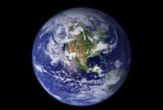New Data Show Global Warming Kills Marine Life

Satellite data revealed for the first time that global warming could devastate key marine life, scientists announced today.
The decade-long analysis showed that as the surface water of the oceans warmed up, phytoplankton biomass declined.
Tiny marine plants, called phytoplankton, impact the network of organisms that directly or indirectly depend on them for food. Changes in ocean color--a measure of phytoplankton mass--detected from space allowed researchers to calculate their photosynthetic rates and correlate these changes to the climate.
As rising air temperatures heat up the ocean's surface, this water becomes less dense and separates from the cold dense layer below, which is full of nutrients. Since phytoplankton need light for photosynthesis, these floating plants are restricted to the surface layer--now separated from nutrients needed for growth.
When phytoplankton is abundant, the color of the water shifts from blue to green. These marine plants remove carbon dioxide and convert it to organic carbon, accounting for almost half of the Earth's photosynthesis.
During periods of cooler temperatures, there is a flowering of these marine plants. Such was the case in late 1999 when the oceans were recovering from a strong El Nino and the globe was cooling.
But between 2000 and the present, researchers found that as the oceans warmed and became more stratified, phytoplankton productivity declined by 190 million tons of carbon each year.
Sign up for the Live Science daily newsletter now
Get the world’s most fascinating discoveries delivered straight to your inbox.
"This clearly showed that overall ocean productivity decreases when the climate warms," said lead author Michael Behrenfeld of Oregon State University.
Unlike terrestrial plants that can stick around for hundreds of years, these tiny greens have quick turnover rates. Every two to six days, predators munch down the entire global phytoplankton mass.
"This very fast turnover, along with the fact that phytoplankton are limited to just a thin veneer of the ocean surface where there is enough sunlight to sustain photosynthesis, makes them very responsive to changes in climate," Behrenfeld said. "This was why we could relate productivity changes to climate variability in only a 10-year record. Such connections would be much harder to detect from space for terrestrial plant biomass."
The problem could create a vicious cycle.
As the carbon dioxide levels rise, phytoplankton production is reduced. This means that there will be less ocean plants to uptake this greenhouse gas, which worsens the overall problem, Behrenfeld said.
The study is detailed in the Dec. 7 issue of the journal Nature.
- All About Global Warming
- Top 10 Ways to Destroy Earth
- Study: Marine Species Collapse by 2048
- Images: Under the Sea -- Life in the Sanctuaries
- Bloomin' Baltic: The Earth as Art
- New Diagnosis of Ocean Health










